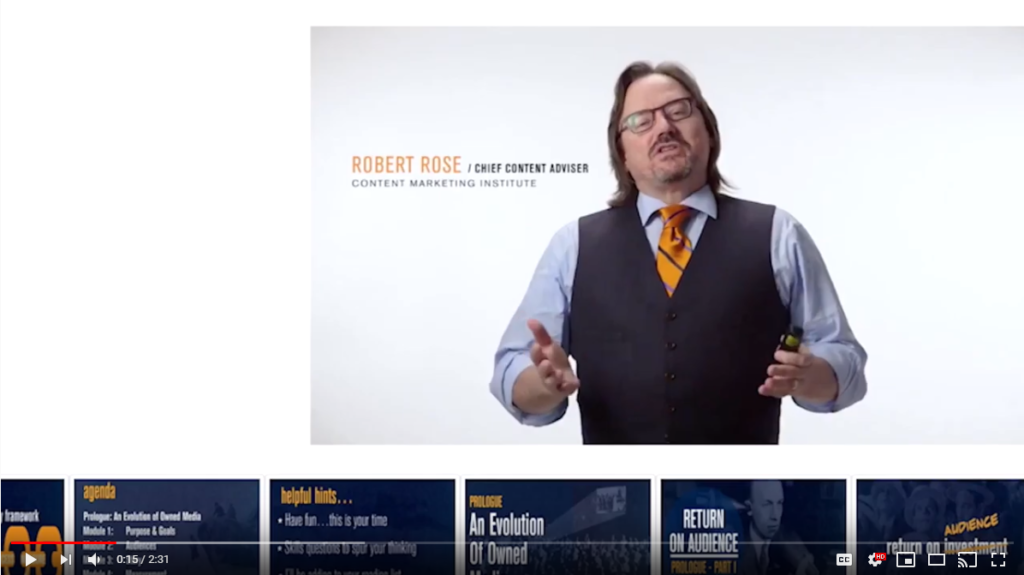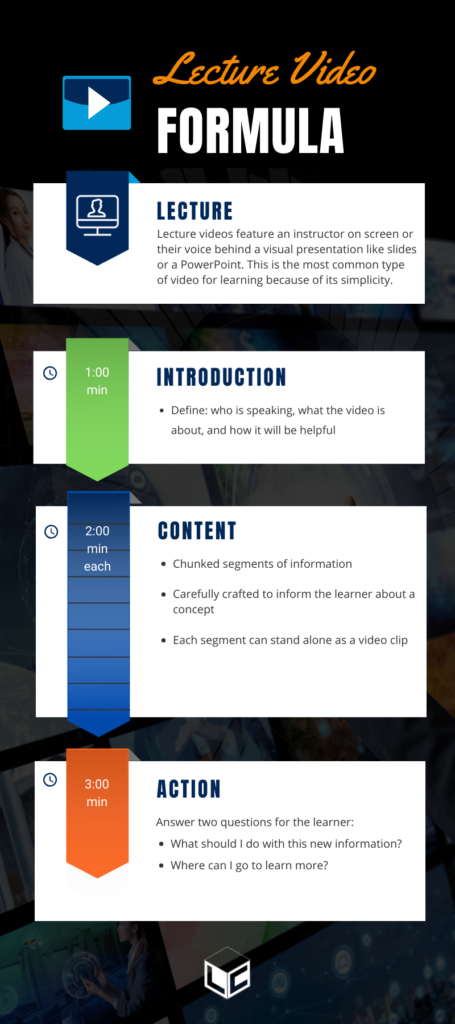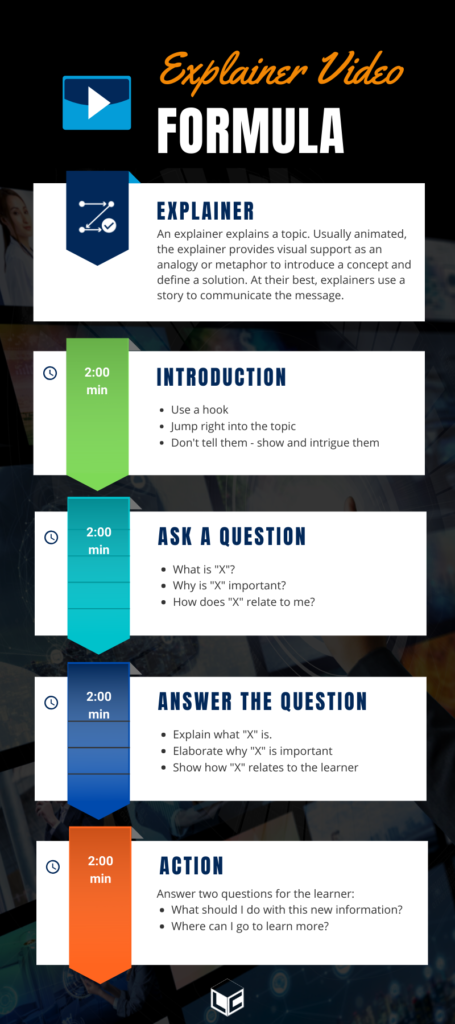I’m on a mission to help people make and use video for learning purposes. This post focuses on three learning video storytelling formulas that will help you write scripts faster. This is part five in the series designed to help you write better video scripts for learning purposes.
Part 1: Scriptwriting for Learning
Part 2: The Writing Process for Learning Videos
Part 3: 4 Must-Have Skills for Writing Scripts for Learning
Part 4: 5 Best Practices as a Learning Video Scriptwriter
Part 5: 3 Learning Video Storytelling Formulas
Part 6: The Mindset for Writing Learning Videos
So, let’s get to it!
The darkside is red,
The light is blue,
Do or do not!
That’s my point of view.
Three Learning Video Storytelling Formulas
Brian Dean of Backlinko has provided the creator community (namely YouTube) with an amazing resource entitled Video Marketing: The Definitive Guide. Chapter 2 of that guide offers four content templates to help creators make marketing videos that will outperform the competition.
“Umb, Chris, you’ve been telling us this whole time that marketing video and learning video are different!” says James, my biggest imaginary follower.
Thank you James, yes. Learning video differs in that its purpose is always to improve the knowledge, skills, and behaviors of the viewer. Marketing video’s purpose is to create awareness, increase engagement, and evoke an answer to a call to action. James is a bit of a kiss-up, but I love him!
I bring up Brian Dean’s definitive guide because it is an outstanding example of learning in the Marketing space. We need a resource like Brian’s in the Learning and Development space. As an homage to Brian’s outstanding work, I propose three storytelling formulas we can use to write better scripts for learning videos.
These formulas are intended to help you quickly write scripts so that you can get to the phases of video production faster.
Storytelling Formulas = Scriptwriter Skill
Successfully using formulas to write is a must-have scriptwriter skill for learning videos. In the 6 Types of Video for Learning, I shared the most common types of instructional videos. Three of those six types – lecture, how-to, and explainer – can be made using a formula. Each of the formulas below will help you craft a script based on best practices and the expectations of your audience.

CMI University Lecture by Robert Rose of the Content Marketing Institute.
Lecture Video Formula
Lecture videos usually contain talking heads discussing a specific topic. They’re ideal for internal communications or delivering a case study to your corporate audience. They also thrive in the area of complex concept communication. In other words, think tech talk or Ted talk. The lecture usually features an expert or an authority on a subject providing answers to questions or explanations of concepts.

Introduction
The person on camera (also known as the “talking head”) should introduce themselves. This needs to be brief, about one minute in length, and not self-aggrandizing. In other words, avoid pontification and self-important bragging. However, a solid lecture should give enough background on the talking head so the learner has confidence that the speaker is an authority on the subject matter.
In a few sentences the talking head should explain who they are, what the video is about, and how it will be helpful.
Content
The middle of the video should provide a more detailed description of the content and its usefulness. State the point, provide details, and elaborate briefly!
Chunking information is an eLearning buzzword. Omer says chunking is, “The process of breaking down content into smaller, bite-sized bits of easily digestible information that are easy to comprehend, learn, and commit to memory” (Content Chunking).
A lecture video should be chunked. You can do this by preparing the skilled lecturer to design their presentation in chunks, or you can edit the video after it has been recorded to create segments. Ideally, you should plan to chunk the information before recording, but I know some of us do not have that luxury.
Separate the segments by an image and title so it is clear to the learner/viewer where one segment ends and a new one begins. Chunking your lecture content will also allow you the ability to separate the video into smaller, shareable video clips.
Action
At the end of the video, you want to explicitly answer these two questions for your audience of learners: What should I do with this new information? Where can I go to learn more?
How-To Video Formula
How-To videos feature step-by-step instructions that show a specific process for completing a task.

Introduction
Open the video with a brief statement that delivers on what the title suggests. For example, if you are offering your learning audience a video on how to use Google Docs, then your introduction would sound like this: “If you are new to Google Docs, or even if you have some experience but want to know more, then this video is for you. Over the next few minutes, we are going to …”
Content
A good how-to video is organized linearly. This allows the learning audience to follow along and build on each previous step as new information is shared.
Be obvious, straightforward, and authentic. This is not the time or place for cinematic or animated drama. Clear and concise steps will instruct your audience most effectively.
The steps should be clearly communicated. If there are only a handful of them, then the narrator saying “step one, two, three, etc” before each step will be effective. If there are more than five steps, consider creating on-screen text to reduce the repetition.
Action
At the end of the video, summarize the list of steps. Then, show your audience where to go to learn more.
Invite them to demonstrate their new skill by participating in a knowledge check or give them ideas on how to practice on their own.

Redgrave Education and Training Explainer Video by Learning Carton
Explainer Video Formula
Explainers usually feature a detailed description of a process or concept by a person on-screen talking directly to the camera. It could also be animated video with or without narration that features moving pictures and text. Because they are ideal for information sharing, the explainer is one of the most common educational video types in circulation.

Introduction
Get right to it. Use a hook to gain the learners’ attention. This could be a question, puzzling image, or statement of a problem. You can even make a promise at the beginning of the video such as “We guarantee, that by the end of this video, you will be an expert on basic quantum mechanics!”
Ask a question
Address the questions: Why is this interesting? Why is it important to the learner? You can either answer these explicitly or write your script in a way that answers them. For example, you may ask, “What is quantum mechanics anyway?”
Answer the question
Once you’ve posed the question to the learner, answer it for them. An explainer learning video’s sole purpose is to provide information to the learner in the form of an explanation. Continuing our example on quantum mechanics, this might be: “What is quantum mechanics, anyway? Well, it is the branch of mechanics that deals with the mathematical description of the motion and interaction of subatomic particles. But that’s just a vague definition am I right? What it really means is…”
Repeat steps 2 and 3 of the formula until you have completely explained the topic. For example, once you’ve answered the question, “What is it?” you are ready to ask, “Why is it important?” and then finally, “How does it relate to you?”
Action
As you conclude the explainer you should answer these two questions for your audience of learners: What should I do with this new information? Where can I go to learn more?
Remember, the purpose/promise of video for learning is to improve knowledge, skills, and behaviors.
Summary
The quest to write better video scripts for learning requires practice. Using templates and formulas to speed up the process will help you. The three common storytelling formulas for learning video will help you build upon proven forms that your learning audiences will expect. As you craft your scripts using these formulas, always keep sight of the purpose of learning video: to improve the knowledge, skills, and behaviors of the learner. And by all means, keep writing! You will be better tomorrow than you are today!
Helpful Links
Are you new to learning about video for learning? Consider reviewing my four-part series, Video for Learning Fundamentals.
Part 1: The Case for Video
Part 2: We Need Learning Video Production Skills
Part 3: 5 Phases of Video Production for Learning
Part 4: The Glossary of Learning Video Terms
Join my feedback loop
What formula or template for learning video do you need? Drop me a note and let me know.
If you liked what you read, and would like to join the conversation, please consider subscribing to my newsletter to receive free learning resources delivered to your inbox every two weeks.
I love feedback loops. As Elon Musk said, “I think it’s very important to have a feedback loop, where you’re constantly thinking about what you’ve done and how you could be doing it better.”
THE END



